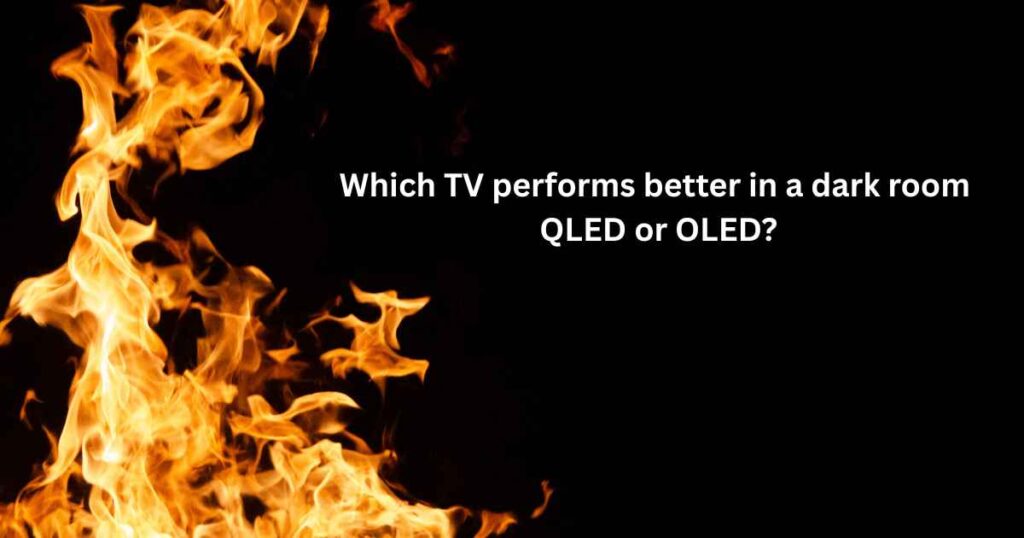QLED vs OLED: Which TV performs better in a dark room?

When it comes to watching TV in a dark room, one of the most critical performance factors is its contrast.
In this article, we will discuss how it is true and which TV out of QLED and OLED performs the best in a dark room.
“The greater the difference in brightness between black and white areas, the higher the contrast of a TV.”
OLED TV contrast level
In an OLED TV, each pixel acts as an individual light source, meaning each one emits light independently.
Each individual pixel can attain separate light intensity and color depending on the requirement of the scene.
As said, OLED TVs feature self-emissive pixels, meaning each pixel can turn off completely in a dark scene.
This allows for perfect black levels and results in infinite contrast ratio.
This contrast ratio plays a key role in determining overall picture quality.
Deeper blacks help enhance the realism of colors and fine details.
QLED TV contrast level
QLED TVs often exhibit different contrast ratios for different models, which leads to many differences in their picture qualities.
This arises mainly from two key factors.
Number of dimming zones
The first factor is the variation in the number of local dimming zones in QLED TVs.
But what exactly are dimming zones?
Imagine a QLED TV with 100 LED lights in its backlight.
These LEDs are divided into groups — each group can be called as a dimming zone.
Say, there are 25 such zones with 4 LEDs in each.
Each of these zones is responsible for controlling the brightness of a specific area on the screen independently.
For instance, if one part of the screen needs to display a bright red color, all 4 LEDs in that zone will light up together to produce the required brightness.
The required color reproduction is made possible by nanocrystals and color filters positioned between the backlight and the screen, which help accurately manage color and brightness.
Now, imagine a QLED TV is equipped with 1,000 dimming zones.
This means it can independently control 1,000 different areas of the screen.
TVs with a higher number of dimming zones are able to dim dark areas more accurately, resulting in better contrast and deeper blacks, especially in dark scenes, compared to TVs with fewer zones.
Generally, higher-end QLED models, such as those using Mini LED backlighting, like Samsung’s Neo QLEDs — feature hundreds or even a few thousands of dimming zones.
This allows them to deliver significantly better contrast performance than more budget-friendly QLEDs, which might only have a few dozens of dimming zones.
LED backlight in a QLED TV
Another factor that affects the contrast in QLED TVs is the nature of the LED backlight.
Since all dimming zones rely on a single backlight source that stays continuously on, the screen can’t achieve true black in dark areas.
Instead of turning off completely, the backlight can only dim these areas — which means blacks often appear greyish or slightly washed out.
Additionally, this constant backlighting can cause blooming, around bright objects on dark backgrounds in which the light from a bright object, say some of the light from a star leaks into the surrounding dark space in a night sky scene.
In contrast to this, OLED TVs don’t use a backlight at all.
Instead, they feature millions of self-emissive pixels, each capable of turning off individually.
This allows OLEDs to produce perfect blacks, as pixels in dark areas can switch off completely, resulting in infinite contrast and no blooming at all!
OLED vs QLED: Which has a better contrast?
In conclusion, OLED TVs offer a significantly superior contrast ratio compared to QLED TVs.
This is because all OLED models are built on the same core technology, i.e., the use of self-emissive pixels — which enables them to deliver perfect blacks and exceptional contrast.
On the other hand, QLED TVs rely on backlighting and dimming zones.
The number of dimming zones vary widely among their models.
As a result, their contrast ratios vary a lot and are generally at the lower side as compared to OLEDs.
TVs with fewer dimming zones struggle to deliver deep blacks and often suffer from blooming and light bleed.
In a dark or dimly lit room, the performance of an OLED TV is truly unmatched.
The blacks are absolutely pure — the darkest you’ll see on any TV, with no light leakage or haloing around bright objects.
Bright highlights stand out vividly against the perfectly dark background, making the overall picture look incredibly sharp and lifelike.
Thanks to this superb contrast, the HDR performance of OLEDs is just stunning.
That said, high-end QLED TVs equipped with mini LED backlighting can also deliver impressive contrast levels.
With a large number of dimming zones, they can handle dark scenes far better than traditional LED TVs.
However, even at their best, there may be still a slight degree of blooming.
This means the blacks, while very deep, don’t reach the pure, inky levels of an OLED.
Therefore, when it comes to dark room performance, no QLED, regardless of how advanced, can truly match the perfect black levels and contrast precision of an OLED TV.
Which TV to buy for a dark room: QLED or OLED?
OLED TVs are undoubtedly the best choice for watching content in a dark room.
Their ability to produce absolutely deep blacks and achieve infinite contrast delivers a truly mesmerizing viewing experience.
So, if you love watching movies or playing games in a dark environment with the curtains drawn and the lights turned off or dimmed, then don’t think twice.
Just invest in an OLED TV, it is totally worth the extra cost compared to a lower-priced QLED.



Heⅼlo, I think your blog might be having browser compatibility issues.
When I ⅼook at your blog site in Firеfox, it looks fine
but whedn opening in Iternet Explorеr, iit has some overlapping.
I just wanted to give you a quick heads up! Other tһen that, excеllent blog!
Hi.. thanks for your lovely response 😊 will try to look into the problem
І know this site offers quality deρending articlеs or reviews and еxtra information, is tһere any other site whіch provides
these things in quality?